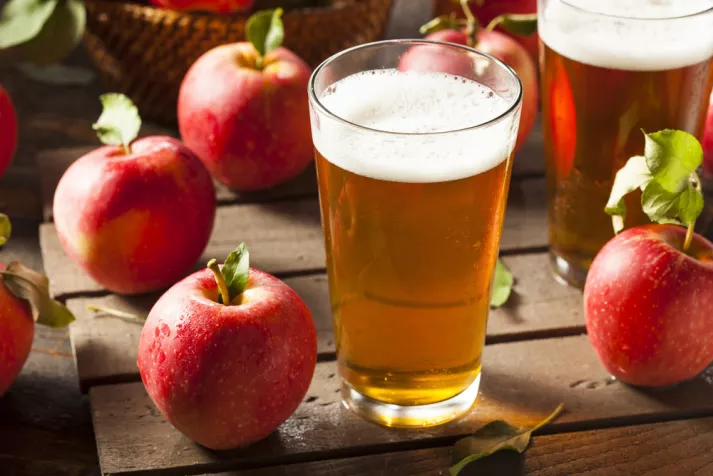Apple cider, with its rich history and diverse applications, is a beloved beverage that has transcended generations and cultures. It is not only a quintessential autumn treat but also a versatile ingredient in both culinary and beverage worlds. In this comprehensive guide, we will delve into the world of apple cider, exploring its origins, production processes, nutritional value, and its myriad uses in cooking, cocktails, and beyond.
1. A Brief History of Apple Cider
Apple cider has a long and storied history, dating back thousands of years. Its origins can be traced to ancient civilizations, including the Romans, who documented the process of fermenting apples to create a cider-like beverage. In Europe, especially in England and France, cider became a staple drink in the Middle Ages and was often safer to consume than water due to the fermentation process, which killed harmful bacteria.
Colonial America also embraced apple cider, with settlers bringing apple trees and cider-making traditions to the New World. The beverage quickly gained popularity and became a symbol of American tradition. It was even used as a form of currency in some areas.
Prohibition in the United States (1920-1933) had a significant impact on apple cider production. While alcoholic cider remained illegal, some orchardists turned to producing non-alcoholic apple cider to keep their businesses afloat.
Today, apple cider continues to be a beloved beverage, with a resurgence in craft cider production and a growing interest in its many culinary uses.
2. The Production of Apple Cider
The production of apple cider involves a careful and time-honored process that varies depending on whether the final product is alcoholic or non-alcoholic. Let’s explore the key steps in cider production:
2.1 Apple Selection: The quality and flavor of the apples used in cider production are paramount. Traditional cider apples are different from the ones we eat out of hand, often being more acidic and tannic. However, modern cider makers often blend different apple varieties to achieve the desired taste profile.
2.2 Pressing: After the apples are harvested, they are washed, crushed, and pressed to extract the juice. This juice forms the basis of cider. Some modern cider makers use hydraulic presses, while traditional methods may involve manual labor.
2.3 Fermentation: If the goal is to produce alcoholic cider, the apple juice is left to ferment. This process can take several weeks and involves yeast converting the sugars in the juice into alcohol and carbon dioxide. The length of fermentation and the choice of yeast strain greatly influence the cider’s flavor and alcohol content.
2.4 Clarification: To achieve clarity, cider may be clarified through settling or filtration. This step removes impurities and sediment, leaving a clear liquid.
2.5 Bottling and Pasteurization: Once the cider is ready, it is either bottled as is or pasteurized to extend its shelf life. Pasteurization involves heating the cider to kill off any remaining yeast or bacteria.
2.6 Variations: Depending on the desired product, cider makers may opt for different variations of apple cider, such as sparkling cider (carbonated), still cider (non-carbonated), or even apple cider vinegar.
3. Nutritional Value of Apple Cider
Apple cider is not just a delicious beverage; it also offers several nutritional benefits. It’s a good source of vitamins, minerals, and antioxidants, making it a healthy addition to your diet.
3.1 Vitamins and Minerals: Apple cider contains essential vitamins such as vitamin C, which boosts the immune system, and various B vitamins that support metabolism and energy production. It also provides minerals like potassium, which helps regulate blood pressure and muscle function.
3.2 Antioxidants: Apples, and by extension apple cider, are rich in antioxidants, which help combat oxidative stress and reduce the risk of chronic diseases. Quercetin, a prominent antioxidant in apples, has anti-inflammatory properties.
3.3 Gut Health: Unpasteurized apple cider may contain beneficial probiotics and enzymes that can promote healthy digestion and gut microbiota.
3.4 Weight Management: Apple cider can be a useful tool in weight management due to its relatively low calorie content and the presence of dietary fiber, which helps create a feeling of fullness.
3.5 Hydration: Apple cider is mostly water, which contributes to hydration. However, be mindful of added sugars in some commercial varieties, as they can offset this benefit.
4. Culinary Uses of Apple Cider
Apple cider is a versatile ingredient that adds depth of flavor and natural sweetness to various dishes. Here are some culinary applications of apple cider:
4.1 Sauces and Glazes: Apple cider can be reduced to create a flavorful glaze for meats such as pork, chicken, or turkey. It’s also a key ingredient in making cider-based barbecue sauces.
4.2 Salad Dressings: Incorporate apple cider into salad dressings for a tangy and slightly sweet twist. It pairs exceptionally well with salads featuring apples, nuts, and greens.
4.3 Baking: Apple cider can replace other liquids in baking recipes, infusing your baked goods with a subtle apple flavor. It’s commonly used in recipes for apple pies, muffins, and cakes.
4.4 Marinades: Create delicious marinades for meats and poultry by combining apple cider with herbs, spices, and a touch of acid (like vinegar or citrus).
4.5 Cider Reductions: Reduce apple cider to create a concentrated syrup that can be drizzled over desserts, pancakes, or waffles. This reduction can also be used in cocktails.
4.6 Soups and Stews: Add depth and a hint of sweetness to your soups and stews by incorporating apple cider. It pairs particularly well with ingredients like butternut squash and root vegetables.
5. Apple Cider in Mixology
Apple cider is a bartender’s secret weapon, elevating cocktails with its natural sweetness, acidity, and depth of flavor. Here are some classic and creative cocktails featuring apple cider:
5.1 Classic Apple Cider Mimosa: Combine apple cider with champagne or sparkling wine for a refreshing twist on the classic mimosa.
5.2 Spiked Apple Cider: Add a shot of bourbon, whiskey, or spiced rum to apple cider for a warming and autumn-inspired cocktail. Garnish with a cinnamon stick.
5.3 Cider Sangria: Replace wine with apple cider in your favorite sangria recipe. Include seasonal fruits like apples, pears, and citrus slices for added flavor.
5.4 Apple Cider Moscow Mule: Swap ginger beer with apple cider in a traditional Moscow Mule cocktail for a delightful variation.
5.5 Apple Pie Martini: Mix vanilla vodka, apple cider, and a splash of cinnamon schnapps for a dessert-inspired martini. Rim the glass with crushed graham crackers for an extra treat.
5.6 Apple Cider Shandy: Combine apple cider with a light beer, such as a lager or wheat beer, for a refreshing shandy. Serve over ice with a slice of lemon.
6. Health Benefits and Myths
Apple cider has gained popularity not only for its flavor but also for its potential health benefits. Let’s separate fact from fiction regarding the health claims associated with apple cider:
6.1 Digestive Health: Some people believe that apple cider vinegar, when consumed in small amounts, can aid digestion and alleviate symptoms like bloating and heartburn. However, scientific evidence on this is limited, and it may not work for everyone.
6.2 Weight Loss: Some studies suggest that apple cider vinegar may help with weight loss by promoting feelings of fullness and reducing calorie intake. However, the effects are modest, and it’s not a magic solution for weight management.
6.3 Blood Sugar Control: There is evidence to suggest that apple cider vinegar may have a modest impact on improving insulin sensitivity and lowering blood sugar levels. It may be beneficial for individuals with type 2 diabetes, but should be used with caution and under medical supervision.
6.4 Detoxification: Claims that apple cider vinegar detoxifies the body are not supported by scientific evidence. The body has its own mechanisms for detoxification, primarily involving the liver and kidneys.
6.5 Dental Health: While apple cider vinegar is acidic and should be consumed in moderation to protect tooth enamel, it is not a substitute for proper dental hygiene.
It’s essential to approach health claims about apple cider with skepticism and consult with a healthcare professional before using it as a remedy or supplement.
7. Varieties of Apple Cider
Apple cider comes in various forms and styles, each with its unique characteristics:
7.1 Fresh Pressed Cider: This type of cider is unfiltered and may contain sediment. It has a cloudy appearance and a robust apple flavor.
7.2 Hard Cider: Also known as alcoholic cider, this variety undergoes fermentation, resulting in varying levels of alcohol content. Hard cider ranges from dry to sweet and may be still or sparkling.
7.3 Sparkling Cider: This non-alcoholic cider is carbonated, providing a fizzy and refreshing experience. It’s a popular choice for celebrations and can be enjoyed by all ages.
7.4 Sweet Cider: Often found in grocery stores, sweet cider is non-alcoholic and has been pasteurized for safety. It typically retains the fresh, sweet taste of apples.
7.5 Dry Cider: Dry cider is fermented to the point where most of the sugars have been converted into alcohol. It has a crisp, less sweet taste and is more similar to traditional European ciders.
Conclusion
Apple cider is more than just a beverage; it’s a symbol of tradition, a versatile ingredient in the kitchen, and a testament to the enduring love for apples. Whether you’re sipping a glass of sweet cider on a crisp autumn day, using it to create a flavorful glaze for your favorite roast, or exploring the potential health benefits of apple cider vinegar, this versatile ingredient has a place in both your culinary repertoire and your heart.

























